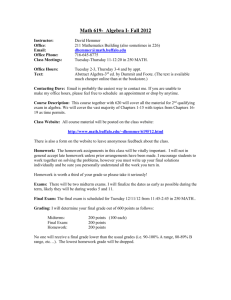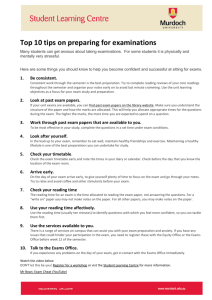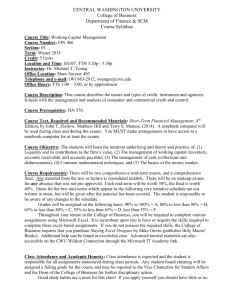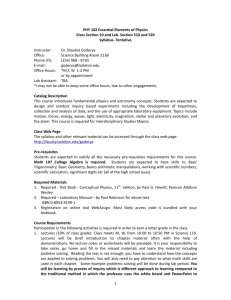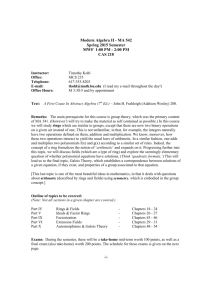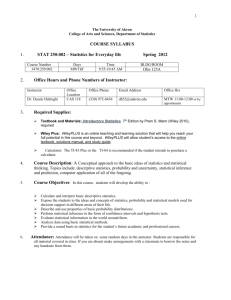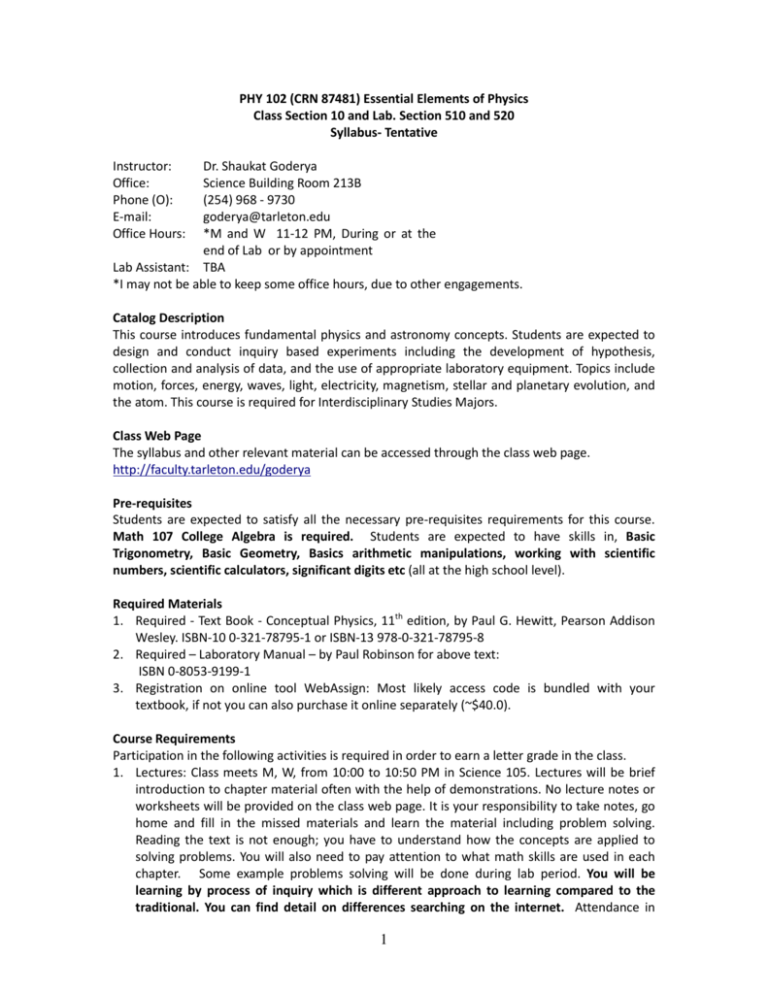
PHY 102 (CRN 87481) Essential Elements of Physics
Class Section 10 and Lab. Section 510 and 520
Syllabus- Tentative
Instructor:
Office:
Phone (O):
E-mail:
Office Hours:
Dr. Shaukat Goderya
Science Building Room 213B
(254) 968 - 9730
goderya@tarleton.edu
*M and W 11-12 PM, During or at the
end of Lab or by appointment
Lab Assistant: TBA
*I may not be able to keep some office hours, due to other engagements.
Catalog Description
This course introduces fundamental physics and astronomy concepts. Students are expected to
design and conduct inquiry based experiments including the development of hypothesis,
collection and analysis of data, and the use of appropriate laboratory equipment. Topics include
motion, forces, energy, waves, light, electricity, magnetism, stellar and planetary evolution, and
the atom. This course is required for Interdisciplinary Studies Majors.
Class Web Page
The syllabus and other relevant material can be accessed through the class web page.
http://faculty.tarleton.edu/goderya
Pre-requisites
Students are expected to satisfy all the necessary pre-requisites requirements for this course.
Math 107 College Algebra is required. Students are expected to have skills in, Basic
Trigonometry, Basic Geometry, Basics arithmetic manipulations, working with scientific
numbers, scientific calculators, significant digits etc (all at the high school level).
Required Materials
1. Required - Text Book - Conceptual Physics, 11th edition, by Paul G. Hewitt, Pearson Addison
Wesley. ISBN-10 0-321-78795-1 or ISBN-13 978-0-321-78795-8
2. Required – Laboratory Manual – by Paul Robinson for above text:
ISBN 0-8053-9199-1
3. Registration on online tool WebAssign: Most likely access code is bundled with your
textbook, if not you can also purchase it online separately (~$40.0).
Course Requirements
Participation in the following activities is required in order to earn a letter grade in the class.
1. Lectures: Class meets M, W, from 10:00 to 10:50 PM in Science 105. Lectures will be brief
introduction to chapter material often with the help of demonstrations. No lecture notes or
worksheets will be provided on the class web page. It is your responsibility to take notes, go
home and fill in the missed materials and learn the material including problem solving.
Reading the text is not enough; you have to understand how the concepts are applied to
solving problems. You will also need to pay attention to what math skills are used in each
chapter. Some example problems solving will be done during lab period. You will be
learning by process of inquiry which is different approach to learning compared to the
traditional. You can find detail on differences searching on the internet. Attendance in
1
class will contribute towards your participation grade.
2. Laboratory (40 % ): The laboratory component is the most vital part of the class. Official time
is 2:00 – 4:50PM Monday for section 20 and 2:40-5:30 PM Tuesday for Section 20 in science
235. Expect to stay for full period during the Lab. No excuses will be accepted. Do not
schedule any appointments during this period. Do not take this class if you do not have time
for the full lab period.
2.a) Laboratory work (40%):
Activities: Student will do various laboratory experiments and activities and learn
problem solving skills. Active participation in the lab activities will contribute to your
extra credit.
Lab Exam (30%): There will be 2 three hours Lab exams during the semester. The exam
will have questions in which you will have to solve problems and show detail correct
work to get full credit. You may be asked to do an experiment and collect data and
answer questions based on your analysis of the data. Because we have two lab sections
your lab exam will be different from the other section.
Project (10%): There will be one model making projects: Details to come later.
3. Homework (15%): I will assign homework using WebAssign. The problems are based upon
your textbook end of chapter problems. Homework will help you prepare for exams and the
final.
4. Exams (30%): There will be 3 one hour class exams. Each exam will have 25 multiple choice
questions. Only the best 2 exam scores will be counted towards your grade, the lowest class
exam score will be dropped.
5. Final (15%): The final exam will be comprehensive and will have only multiple choice
questions. There is a possibility that I may have to give the final early due to my travel to
complete scholarly assignments.
6. Extra Credit: You have the opportunity to earn extra credit. The weight of extra credit for the
class will be least 3% of total grade (100), but can be more if I so decide to change it for the
whole class. To determine the extra credit I will take random attendances during the class
hour and during the lab hour. To earn full extra credit you must satisfy the conditions 6a, 6b
and 6d.
6.a) Have 75% or more of all attendances I take in class, not counting the class exam days and
6.b) Have 90% or more of all attendances I take in Lab, not counting the lab exams
In case you do not satisfy either 6a, and 6b you can still get full credit if you satisfy
conditions 6c and 6d.
6.c) Have 30+% of the 40% of the Lab exam and 20+% of the 30% of the Class Exams or 100%
in the final exam and
6.d) At no point during the semester I have to warn you of cheating during the exams or
misbehavior during the class or lab time thus disturbing the class.
Absence and Makeup Policy
Class absence policies will be established and enforced. The course instructor may recommend
to the Dean of Students that a student be dropped from a course if excessive absences prevent
satisfactory progress (TSUSH). Random attendance will be recoded for this course. The student is
responsible for any material covered.
2
1. No makeups for missed test or exams will be allowed after they are handed back to
the students in class (in most cases one week).
2. No makeup for missed labs or activities will be allowed beyond the next lab period.
3. There is no makeup for finals, although you may be able to reschedule the exam for an
earlier date.
ADA accommodations
In compliance with the American Disabilities Act (ADA), reasonable accommodations will be
made for any student with documented physical or learning disabilities.
Students with disabilities may request appropriate accommodation by contacting the Director
of Student Disability Services in the Mathematics Building, Room 201, at 254-968-9400 or at
disability@tarleton.edu
Drop Policy
A student who withdraws from a course before the thirteenth class day of a regular semester or
before the fifth class day in summer term receives no grade, and the course will not be listed on
that student’s permanent record. A student who withdraws from the course before the end of
the tenth week of a regular semester or the fourteenth class day of a summer term receives a
grade of W (TSUSH).
Academic Conduct
1. Students are responsible for knowing and abiding by the policies and information
contained in the Tarleton Student Handbook (TSUSH)
2. In accordance with University's Academic Dishonesty Policy (See TSUSH) any act of
dishonesty, cheating, or plagiarism in pursuing course work will be penalized. Examples
include cheating during the exam or on the final and copying answers from someone
else in homework projects or laboratory report.
3. If your classroom is equipped with computers, you should not use computers in any
activity (email, internet browsing, chat, etc) during class time, unless the instructor
specifically gives you special permission for doing class related work or the computers
are used in conjunction with lecture materials.
4. Cell phone use is not allowed in lecture class. During the lab period you can go out of
the room to use your cell phone.
5. During the test and exams no electronic devices other than a scientific calculator will
be allowed. Storing answers in calculator memory is considered cheating. You will be
allowed to bring an equation sheet.
Advise: Your continued registration in the class is considered as a binding agreement on your
part to follow the university requirements, rules and policies.
University Closure
1. In the event that the university is closed for a scheduled class time, whatever was
scheduled for that day and/or whatever was due that day will be scheduled and/or due
on the next scheduled class time
Grades
Your grade for the academic progress alert will be based on class test and/or exam if it is given
before the grades are due. Letter Grades will be assigned according to the following scale after
rounding your scores to 4 significant digits.
Exams
30%
3
Laboratory Exams
Homework’s
Final
Total
40%
15%
15%
100%
A - 89.96 – 100%
B - 79.96 – 89.95%
C - 69.96– 79.95%
D - 60 – 69.95%
F - Less than 60%
These letter grade scales are fixed, that is after the final exam no scaling will be done. However, I
reserve the right to decrease the lower boundaries (that is your grade might increase if you are
near a boundary).
All items contained in this syllabus are subject to change as the semester progresses. Student
will be notified in advance of any changes.
Intended Student Outcomes for this course
1. Conduct laboratory investigations using safe and appropriate practices to include:
a. Planning and implementing procedures
b. Formulating hypotheses
c. Selecting and using equipment and technology
d. Collecting experimental data
e. Analyze data to include constructing graphs and charts, draw inferences and
predict trends
f. Communicate valid conclusions
2. Apply the concepts of motion and Newton’s Laws to analyze and explain physical
phenomena
3. Apply the energy concepts including definitions of heat, potential energy, radiant energy,
and kinetic energy to analyze and explain physical phenomena
4. Apply wave concepts including reflection, refraction, diffraction, and interference to
analyze and explain wave phenomena
5. Apply the properties of light to analyze and explain various optical phenomena including
the formation of shadows, color patterns in oil slicks, why the sky is blue, etc.
6. Be able to describe various historical models of the solar system and the experimental
observations that each model correctly and/or incorrectly predicts
7. Describe the characteristics of the universe such as stars and galaxies
8. Be able to relate the movements of the Earth and moon relative to the sun to various
physical phenomena including the phases of the moon, seasons, length of the day, etc.
9. Be able to use basic concepts in electricity and magnetism to analyze or describe various
electromagnetic phenomena including electromagnetism, DC circuits, motors, and
electrical power generation by electromagnetic induction.
10. Effectively communicate mathematical and scientific information in written and oral
form.
11. Be able to distinguish between an investigable and non-investigable question
12. Be able to describe the cultural, economic, philosophic and political impact of science
discoveries in mechanics, astronomy, and electromagnetism upon society.
4
Important Dates
Labs every week unless noted on dates in this table. Dates are subject to change
Date/Week
Events
Sep 2
Labor Day Holiday
Sep 2
No Lab this week due to Labor day holiday on Monday
Sep 11
Last day to drop class
Sep 23
Class exam 1 During Class
Sep 23 & 24
Lab Exam 1
October 16 Midterm grades due
Oct 23
Class Exam 2
Oct 28 & 29 Project Demonstration and Competition
Nov 11
Class Exam 3
Nov 11 & 12 Lab Exam 2
Nov 25th
Possible Early Final
Nov 27-29
Thanksgiving Break: No Lab this week
Dec 2 & 3
No Lab
Dec 4&5
Last class day/Study period begins
Dec 6
Finals Begin
Dec 11
Final Exam for Class (Wednesday at 3:00-5:30 PM) Normal class room unless
changed. (Possibility of Early Exam)
Topics to be covered
A word about the textbook: There is no one single text book which fits the requirement of the
course syllabus however, the textbook chosen covers nearly all but a few topics. Infect the text
has lot more material than what can be covered in one semester. Therefore we will not be
following the chapters one by one in sequential order. The emphasis is on the topics hence the
course name “Essential Elements of Physics. The homework and exams will be over the topics
covered in class.
Week
1
Topic
Mechanics: Linear Motion
Where is it in the Text?
Chapter 3
2
Mechanics: Free Fall, Newton’s Laws, Law
of Gravity, Projectile motion
Mechanics: Kinetic energy, Potential
energy, Impulse, Momentum,
Conservation Laws and Collisions
Mechanics: Rotation, Centripetal Force,
Satellite Motion, Torque, and Equilibrium,
Center of mass.
Mechanics: Moment of Inertia, Angular
Momentum and Conservation of Angular
Momentum
Fluid Motion: Density, Pressure,
Archimedes principle, Pascal’s principal,
Continuity equation and Bernoulli’s
Chapter 2, 4, 5, 9 and 10
3
4
5
6
5
Chapter 6 and 7
Chapter 8 and 10
Chapter 9
Chapter 13 and 14
7
8
9
10
11
12
13
14
15
theorem
Heat: Temperature Scales, Expansion, Heat
Energy, Phase Change and Calorimeter
Waves and Vibrations: Waves, Reflection,
Refraction, Interference, Diffraction,
Hooke’s Law and Simple Harmonic
Motion
Electricity: Charges, Electric Force, Electric
Field, Electric Potential, Current, AC/DC
and Circuits
Magnetism: Bar Magnets, Magnetic force,
Current and Magnetic Field, Electric
generator and Electric motor.
Electromagnetism: Charge Oscillations,
Radiation Electromagnetic waves, EMSpectrum
Optics: Wave fronts, Rays, Reflection,
Refraction, Mirrors and Lenses, and
pinhole camera, the eye
Astronomy-I: Greek Astronomy, Size of
Earth, Astronomical Distances and Scale,
Precession, Lunar Phases, Eclipses, and
Seasons
Astronomy-2: Black body radiation, Stars,
Stefan’s Boltzmann Law, Wien’s
Displacement Law, H-R diagram,
Classification of Stars, Stellar Evolution
Astronomy-2 Continuation
6
Chapters 15, 16 and 17
Chapters 19
Chapters 22 and 23
Chapters 24
Chapters 25
Chapters 26 and 28
Chapter 1 , class notes and Web
resources
Class notes and Web resources



